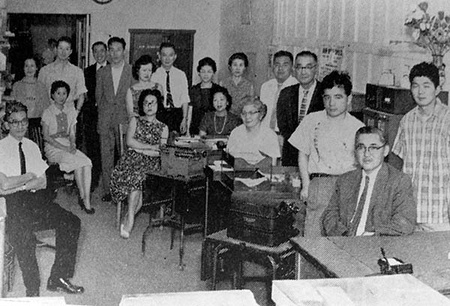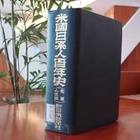Read Part 4: Japanese Americans in Northern California >>
Perhaps because the Shin Nichibei Shimbunsha, which edited "A Centennial History of Japanese Americans in the United States" (1961), was based in Los Angeles, the second chapter of the book, "Southern California," which focuses on Los Angeles, takes up 440 pages out of the book's total 1,431 pages.
The reason why it is so long is that most of it is a who's who of pages, devoted to introducing Japanese and Japanese-Americans who have been active in various fields, including well-known local people who have made successful businesses in Southern California.
Among them is Saburo Kido, the lawyer and president of the book's publisher, Shin Nichibei Shimbunsha. There is also a two-page introduction to the short-lived Shin Nichibei Shimbunsha, including the background to its establishment and the nature of its business.
The company's headquarters is located at 345 E. 2nd St. in Los Angeles, and the photo shows it to be a three-story building. The photo below shows all 18 employees of the company taken inside the company in the spring of 1960. It gives us a glimpse of what it was like when Japanese media was still in its prime.
The advertising articles also feature companies that had recently entered the Japanese market around this time, such as American Honda Motor Company (President: Honda Soichiro), Hollywood Toyota Motor Corporation, and American Shochiku.
The first Japanese was in 1870 (Meiji 3).
"Section 1: The History of Japanese in Southern California" and "Section 2: Japanese Agriculture in Southern California" provide detailed records of the footsteps of the Japanese and the development of agriculture that they established in this area.
According to this, in regards to early Japanese people in Los Angeles, it was confirmed that two Japanese people were living there in 1870 (Meiji 3). It also states, "The oldest historical fact is that in 1887 (Meiji 20), Kohei Tanaka (former president of Bakersfield) traveled to America and established himself in San Diego as a cook for a white family."
In addition, it also says, "In 1893 (Meiji 26), Morita Gunji contracted to purchase trees to plant along the streets of San Bernardino."
Three years later, the first Japanese grocery store opened near Plaza Park on Main Street, and Japanese restaurants in the area prospered, but voices calling for the exclusion of Japanese people also arose. Also, "In 1898, the Santa Fi and San Pedro Railroad forced Japanese people to work on the construction of the Southern California Line. This caused a sudden increase in the number of Japanese in Roppongi, and the following year their number was said to be 2,000."
As of the end of 1906 (Meiji 37), the number of Japanese living in Los Angeles and its suburbs was estimated to be 6,889.
As for agriculture, the first Japanese people worked in the area around 1900, working in citrus and sugar beet orchards. Their numbers then rapidly increased, reaching about 5,000 by 1905, and the size of Japanese-run farms, in order of size, included 2,400 acres of sugar beets, 1,894 acres of celery, 1,280 acres of vegetables, and 687 acres of strawberries.
The 1906 San Francisco earthquake caused a surge in immigrants to the Los Angeles area, but they also faced violence and ostracism from white workers. Later, due to the effects of the First and Second California Japanese Exclusion Land Acts, non-citizens could not own land or become shareholders in land companies, so many Japanese people established land companies like these before the laws were passed.
After the war, agriculture was restricted due to housing development.
After the Great Depression, agriculture in the area flourished, but was completely upended by the outbreak of war between Japan and the United States.
"Those who were able to make some money from their just-to-harvest crops, such as land renters and commission farmers, were lucky, but those who were not were forced to sell them off for next to nothing or to be recruited by creditors. In this state of great confusion, with no idea what the future held, some people swallowed their tears and retreated into the countryside, and others were forced to enter various internment camps," he explains.
Immediately after the war, Japanese Americans were hesitant to return due to anti-Japanese sentiment, but according to records from that time, the first to return as farmers were "said to be Masasuke Nitta from Santa Ana and Yorio Chikazawa from Seirafu." Due to food shortages after the war, the WRA (Wartime Relocation Administration) welcomed Japanese Americans into farming.
However, farmland gradually became smaller due to housing development. Housing began to develop in Orange County around 1950, and farming was restricted especially after the construction of Disneyland.
(Note: Honorifics have been omitted. Quotations have been made as faithfully as possible to the original text, with some modifications. Place names have been based on the way they are written in the "Centennial History." In the next issue, "Japanese in Southern California, Part 2," we will look at the response of Japanese American organizations just before the war.)
@ 2014 Ryusuke Kawai







